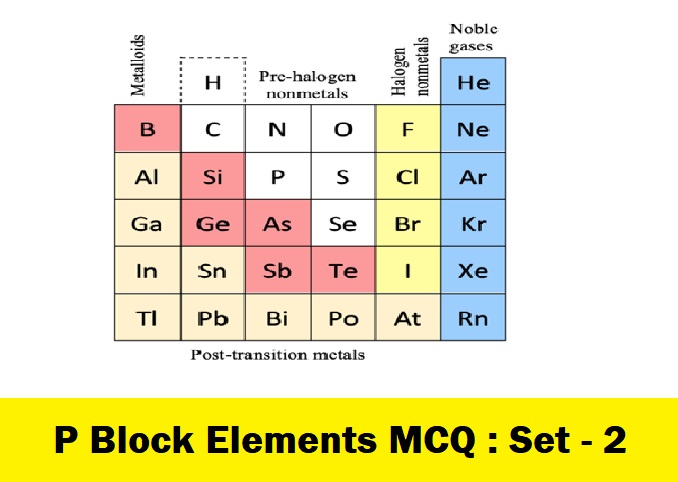CBSE Class 11 Chemistry Chapter 11 The p Block Elements Multiple Choice Questions with Answers. MCQ Questions Class 11 Chemistry The p Block Elements with Answers was Prepared Based on Latest Exam Pattern. Students can solve NCERT Class 11 Chemistry The p Block Elements MCQs with Answers to know their preparation level.
Students who are searching for NCERT MCQ Questions for Class 11 Chemistry The p Block Elements with Answers are compiled here to get good practice on all fundamentals. Know your preparation level on MCQ Questions for Class 11 Chemistry with Answers. You can also verify your answers from our provided MCQ Class 11 Chemistry The p Block Elements with Answers. So, ace up your preparation with MCQ of Chapter 11 Chemistry Objective Questions.
MCQ Questions Class 11 Chemistry The p Block Elements with Answers - Set - 2
Question 1:
Question. Which of the following types of forces bind together the carbon atoms in diamond?
(a) Ionic
(b) Covalent
(c) Dipolar
(d) van der Waals
Correct Answer – (B)
Question 2 :
Question. Identify the correct statements from the following :
(A) CO2(g) is used as refrigerant for ice-cream and frozen food.
(B) The structure of C60 contains twelve six carbon rings and twenty five carbon rings.
(C) ZSM-5, a type of zeolite, is used to convert alcohols into gasoline.
(D) CO is colourless and odourless gas.
(a) (A), (B) and (C) only
(b) (A) and (C) only
(c) (B) and (C) only
(d) (C) and (D) only
Correct Answer – (D)
Question 3 :
Question. Carbon and silicon belong to (IV) group. The maximum coordination number of carbon in commonly occurring compounds is 4, whereas that of silicon is 6. This is due to
(a) availability of low lying d-orbitals in silicon
(b) large size of silicon
(c) more electropositive nature of silicon
(d) both (b) and (c).
Correct Answer – (A)
Question 4 :
Question. It is because of inability of ns2 electrons of the valence shell to participate in bonding that
(a) Sn2+ is oxidising while Pb4+ is reducing
(b) Sn2+ and Pb2+ are both oxidising and reducing
(c) Sn4+ is reducing while Pb4+ is oxidising
(d) Sn2+ is reducing while Pb4+ is oxidising.
Correct Answer – (D)
Question 5 :
Question. Boron compounds behave as Lewis acids, because of their
(a) ionisation property
(b) electron deficient nature
(c) acidic nature
(d) covalent nature.
Correct Answer – (B)
MCQ Questions Class 11 Chemistry The p Block Elements with Answers
Question 6 :
Question. Which of the following does not show electrical conduction?
(a) Diamond
(b) Graphite
(c) Potassium
(d) Sodium
Correct Answer – (A)
Question 7 :
Question. In graphite, electrons are
(a) localised on each C-atom
(b) localised on every third C-atom
(c) spread out between the structure
(d) present in antibonding orbital.
Correct Answer – (C)
Question 8 :
Question. Which of the following oxidation states are the most characteristic for lead and tin respectively?
(a) +2, +4
(b) +4, +4
(c) +2, +2
(d) +4, +2
Correct Answer – (A)
Question 9 :
Question. Boric acid is an acid because its molecule
(a) contains replaceable H+ ion
(b) gives up a proton
(c) accepts OH– from water releasing proton
(d) combines with proton from water, molecule.
Correct Answer – (C)
Question 10 :
Question. Which of the following species is not stable?
(a) [SiCl6]2–
(b) [SiF6]2–
(c) [GeCl6]2–
(d) [Sn(OH)6]2–
Correct Answer – (A)
- NCERT Solutions Class 11 Chemistry Chapter 1 : Some Basic Concepts of Chemistry
- NCERT Solutions Class 11 Chemistry Chapter 2 : Structure Of The Atom
- NCERT Solutions Class 11 Chemistry Chapter 3 : Classification of Elements and Periodicity in Properties
- NCERT Solutions Class 11 Chemistry Chapter 4 : Chemical Bonding and Molecular Structure
- NCERT Solutions Class 11 Chemistry Chapter 5 : States of Matter
- NCERT Solutions Class 11 Chemistry Chapter 6 : Thermodynamics
- NCERT Solutions Class 11 Chemistry Chapter 7 : Equilibrium
- NCERT Solutions Class 11 Chemistry Chapter 8 : Redox Reactions
- NCERT Solutions Class 11 Chemistry Chapter 9 : Hydrogen
- NCERT Solutions Class 11 Chemistry Chapter 10 : The s-Block Elements
- NCERT Solutions Class 11 Chemistry Chapter 11 : The p-Block Elements
- NCERT Solutions Class 11 Chemistry Chapter 12 : Organic Chemistry: Some Basic Principles and Techniques
- NCERT Solutions Class 11 Chemistry Chapter 13 : Hydrocarbons
- NCERT Solutions Class 11 Chemistry Chapter 14 : Environmental Chemistry



